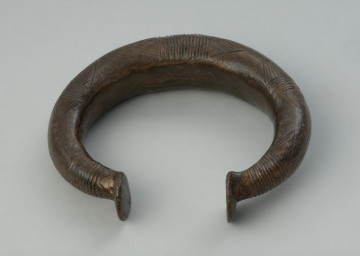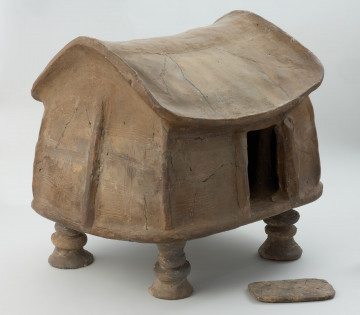
A bracelet with fused ends
around 1700 p.n.e. — 1600 p.n.e.
National Museum in Szczecin
Part of the collection: Bronze Age
This original cylindrical pendant was made from a large amber concretion. Most of its surface is covered with a patina resembling clay, which naturally occurs when amber remains in the ground for hundreds and thousands of years. This exceptionally magnificent product is considered a very rare and mysterious find. It can only be assumed that it served as an amulet. The pendant comes from a cemetery known since the end of the 1830s. It was discovered by accident during the removal of sand, which lasted, probably with significant interruptions, until 1907. It is difficult to establish the exact number of burials uncovered at that time. It is presumed that there may have been about ten of them. The clay vessels then registered were so specific that the necropolis gained the rank of an eponymic site. The name of a new archaeological unit, the so-called Płonia group, synonymous with the Early Bronze Age in Pomerania, was derived from the site. However, the first regular excavations at that important site were undertaken only in 1994 and 1996. As a result, 20 objects were excavated, among which eleven were identified as grave remains. The presented pendant was the equipment of one of them. This grave, dated to c. 2300-2000 BC, survived as an oval pit containing single, relatively large fieldstones, three clay vessels, two small flint tools, and a pendant. The skeleton of the deceased was not preserved in the sandy subsoil.
Dorota Kozłowska
Author / creator
Dimensions
the entire object: height: 8 cm, diameter: 2 mm
Object type
amulet, pendant, bead
Technique
drilling, grinding
Material
amber
Origin / acquisition method
legal transfer
Creation time / dating
Creation / finding place
Owner
National Museum in Szczecin
Identification number
Location / status

around 1700 p.n.e. — 1600 p.n.e.
National Museum in Szczecin

around 1700 p.n.e. — 1600 p.n.e.
National Museum in Szczecin

around 750 p.n.e. — 550 p.n.e.
National Museum in Szczecin
DISCOVER this TOPIC
Museum of King Jan III's Palace at Wilanów
DISCOVER this PATH
Educational path